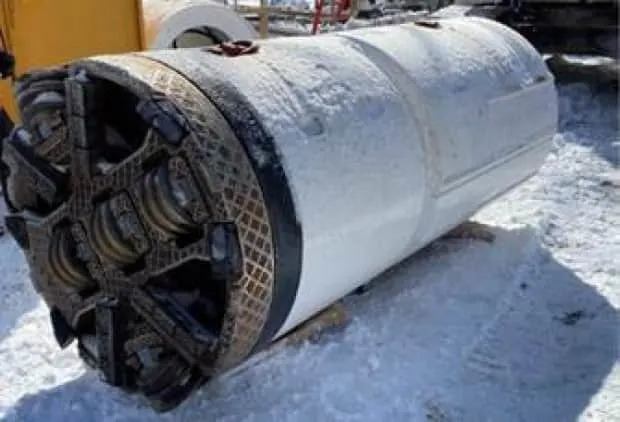Fri, March 3, 2023

Steel tiebacks hang from the face of a micro-tunnelling boring machine used by the city to create a new storm sewer on Old Mill Drive. This picture was taken underground shortly after contractors discovered that machine was struck. The operation to remove it has been complicated by mud and water. (City of Toronto - image credit)
The City of Toronto has launched a delicate rescue operation in the west end that will cost taxpayers $9 million to free a boring machine trapped underground after nearby sewer work went awry last year.
Dozens of workers have been busy for months on Old Mill Drive as they work to excavate the $3-million micro-tunnelling machine, which got trapped near Bloor Street West sometime last spring. A report coming to city councillors Friday says the situation represented a "significant health and safety hazard to the public."
But for people who live and work along the normally quiet street, the project has been a constant headache, says Paul Aiello, who owns a home on Old Mill Drive. The noise, mud and daily flood of construction vehicles is wearing on neighbours, he says.
"There's a lot of inconvenience because we can't get through the streets and there's a lack of communication in terms of what the problem is," he told CBC Toronto as the piercing noise of a construction vehicle's back-up beeper cut him off.
Standing back and watching the vehicle swivel into position as workers move around it, Aiello said: "There's a lot of construction noise, a lot of dirt … even the park is kind of out of commission."
'The road started to collapse'
Greg Tershakowec's dental practice looks out onto the roadway, which is now fenced off to secure the construction zone. He says the disruption has made it hard for some patients to get to his office.
"It is frustrating for me but you have to live with it; you're dealing with the noise all the time," he said.
Tershakowec says it became apparent last spring that something was seriously wrong.
"What happened was that initially the road started to collapse," he said. "And that was the first sign of problems."
The work to dig a new storm sewer on Old Mill Drive began in March 2022. The project was designed to address chronic basement flooding in the area. City staff opted to use a remote controlled micro-tunnelling boring machine, which is 1.5 metres wide and five metres long to create the new sewer tunnel.
The plan was for the machine to be placed 18 metres below ground and have it travel 282 metres to a pre-constructed exit shaft on Bloor Street West. Workers needed to place it deep underground to avoid coming into contact with the nearby Bloor-Danforth subway line.

City of Toronto
But with just seven metres left to go on its route, the machine hit 14 underground steel tiebacks, which had been part of the construction of a nearby condo building. It became ensnared in them, and is now twisted and turned off course.
The city says it didn't know the tiebacks were in place when it initially plotted the route. But a subsequent record search after the machine had hit the tiebacks found that the developer got permission from the city to leave them underground after that project was completed.
Mika Raisanen, a director in the city's engineering and construction services department, says workers hand-dug to the machine, but as work progressed to extract it, damp soil and water have complicated the operation. Now trucks are moving in and out of the area daily to dry the underground soil immediately around the machine.
That will allow workers to pulled the machine apart and remove it in pieces.
'Back to square one'
Raisanen said city staff contemplated a number of options, including leaving the expensive machine in the ground, but that would have meant restarting the project and boring a new tunnel.
"We had to stop the operations and kind of shore up our rescue efforts," he said. "And we did have a couple of sinkholes that came to light and we had to fill them in."
Ultimately, the city began work last spring to extract the machine and finish the last seven metres of the sewer tunnel by hand.
"We look at cost, we look at risk, what can happen, what's feasible," Raisanen said. "And also, the end product if we left it in the ground, where it was. That means we're back to square one."
He says depending on the weather over the next few weeks, and how much moisture workers are dealing with on the site, they hope to rescue the machine by early April. They'll complete the sewer tunnel by hand.
"This exact scenario, I would say, it's not something that we do every day," Raisanen said, asking for patience from residents who he acknowledges have had to live with the disruption.
"We're almost there and completing the project," he said.
"In the end, when the work is done, it'll reduce flooding. That's the intent."
No comments:
Post a Comment